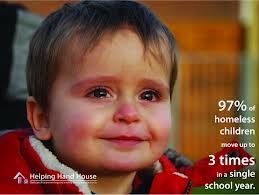Homelessness: Small change good — a big change in attitude better
I’ve always been skittish of those who beg for money on street corners. “Don’t make eye contact … maybe this vagrant will go away,” I’d say to myself. Keeping my windows up, I’d lock the doors, and hope for the light to change. “Where do you live, anyway?” I’d say under my breath, more of a comment then a question.
Slowly, despondently, the man would pass by my locked fortress. I’d lift the phone to my ear, pretending to be on a call. Dehumanize them in my mind, and I don’t have to care.
Recently, I caught a green light and passed a homeless man at breakneck speed. As he got smaller in my rearview mirror, something clicked. I paused, and began to think about where he really might live. “What if he lived inside his own locked fortress?” I thought. Not on a street, but in a car? And what if he wasn’t alone? What if he had a family in there with him?
It turns out it wasn’t a “what if” question at all. It was a “where?” And the “where” seems to be everywhere. It’s all around us. I was driving around in what thousands of families in this country are forced to call “home.”
“There’s this thing called NIMBY-ism,” Brent Trotter, president of the Coalition for the Homeless of Central Florida, told me. “It means ‘not in my back yard.'” The problem is, it’s already there — a Third World emerging right under our noses. And even when we see it, we don’t recognize it. “You don’t recognize it, because homeless people look just like you and me,” Trotter said.
Not recognize it? Surely, Trotter was mistaken. And looking “just like you and me?” Was that some sort of joke? I don’t look like a homeless person — I look, well … I look, normal.
Most of us are just two paychecks away from being homeless. It’s an alarming statistic. Even more disconcerting, according to theU.S. Census Bureau, is the poverty level for a family of four has dropped to just above $22,000 a year. Homelessness is not only a prevalent problem in our country, but a real issue in our own community.
In Seminole County last year, the recession forced Jennifer and her son, 9-year-old Christopher, to move into their car.
Driving from lot to lot, they would sleep in the seats of their cramped, 2003 Ford Focus. Christopher sprawled in the back with a blanket that used to fit his bed. Jennifer stayed in front, keeping watch throughout the night. She cranked the car’s engine for heat, using gas that cost money she didn’t have. The trunk became their closet, the glove box their drawer.
They brushed their teeth in Walmart bathrooms and took showers in the storeroom of a local business owned by a friend. They sneaked in before the store opened — embarrassed to be living out front. While Jennifer worked, Christopher spent the day alongside classmates who never knew there was anything wrong. Homework took place at the public library, dinner at a fast-food restaurant, then back to the parking lot: “home” for the night.
Their clothes were never dingy. Jennifer didn’t push shopping carts along sidewalks, and the Nikes Christopher wore were purchased at a thrift store. They didn’t look like typical homeless, because there’s nothing typical about it.
Throwing change into the Salvation Army kettle is but a drop in the bucket. Though the holidays are over, the destitute are still out there. Homelessness isn’t a seasonal problem. And homeless people are just that: people.
Trotter issued a challenge: Run toward that which disturbs me. And while I may not be running at an all-out sprint, I am moving in that direction. I realize now, not only has the face of homelessness changed; it’s becoming all too common. And it’s not just about giving change — it’s about changing the way I perceive homelessness and those who endure it.
It starts with one person — one person changing his mind, so his heart can follow. I changed my mind about what homelessness looks like, and that has changed the heart of the matter for me. I’m hopeful others will follow.
“Never doubt that a small, group of thoughtful, committed citizens can change the world,” anthropologist Margaret Mead said. “Indeed, it is the only thing that ever has.”


Reblogged this on End Child Hunger Advocacy Center and commented:
Great insight, inspiring call to action.